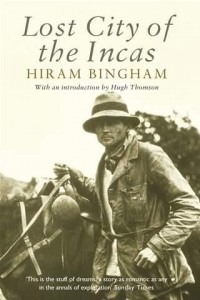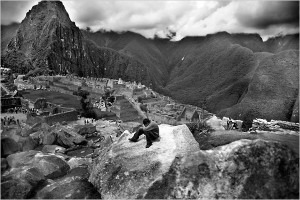
 Following up on the heels of RCA, another
Following up on the heels of RCA, another
famous explorer-archaeologist (treasure hunter *gasp*) is Hiram Bingham III. (there was at least a IV, but I am not sure what number the family is up to now) Bingham was born in Honolulu, Hawaii quite some years before those nice American missionaries displaced the the Hawaiian Queen. Bingham makes the list for many of the same reasons that Andrews did: for example. he wore a hat. He also tromped about South America in field gear.
 On a more serious note, while working at Yale University Bingham rediscovered the lost mythical city of Machu Picchu. Rumor has it that the team was about to give up when a young Andean lad met one of Bingham’s men at a cantina/saloon/coffeeshop and said he knew of a trail that led to a lost city. If he knew the trail I am not sure why exactly the city was still “lost” but for the sake of argument it was lost to the white man. I suppose Pizarro saw it and after all was forgotten it became “lost” again. Anyway, Bingham’s contribution to Dr. Jones may lie in his job at Yale: lecturer of South American History. In fact, Bingham was never trained in Archaeology. Another facet of character development could be grandfathered by the number of folks who came forward after Bingham (and the National Geographic Society) announced the discovery of Machu Picchu. A British Missionary, Thomas and a German engineer, J. M. Hassel came forward claiming to have seen the city first. No one really trusts engineers, but would a missionary lie? Bingham was the son of missionaries himself. That would have been a great anthropological battle going on in newspapers had Bingham and Payne parlayed fisticuffs in text.
On a more serious note, while working at Yale University Bingham rediscovered the lost mythical city of Machu Picchu. Rumor has it that the team was about to give up when a young Andean lad met one of Bingham’s men at a cantina/saloon/coffeeshop and said he knew of a trail that led to a lost city. If he knew the trail I am not sure why exactly the city was still “lost” but for the sake of argument it was lost to the white man. I suppose Pizarro saw it and after all was forgotten it became “lost” again. Anyway, Bingham’s contribution to Dr. Jones may lie in his job at Yale: lecturer of South American History. In fact, Bingham was never trained in Archaeology. Another facet of character development could be grandfathered by the number of folks who came forward after Bingham (and the National Geographic Society) announced the discovery of Machu Picchu. A British Missionary, Thomas and a German engineer, J. M. Hassel came forward claiming to have seen the city first. No one really trusts engineers, but would a missionary lie? Bingham was the son of missionaries himself. That would have been a great anthropological battle going on in newspapers had Bingham and Payne parlayed fisticuffs in text.
 Recent developments had discovered that another German, Augusto Berns purchased land opposite Machu Picchu in the 1860s and initiated various schemes to raise money in order to pillage his neighbor. There is a 2008 write up on in it the Independent (found here) discussing Berns, plunder, governmental permission, and an 1874 map showing the location of the “lost” city. But, the chinese have a 600 year old map that shows Antarctica and no one believes them, so there you go. So, mainly known as a teacher and discoverer of a “lost” Incan city, turned his hands to politics and served as a Republican U.S. Senator from Connecticut, 69th Governor and 58th Lieutenant Governor of the same. Bingham died in 1956 at age 80, proving that there may possibly be a few more Indiana Jones movies in store. (Indiana Jones and the Sacred Filibuster?)
Recent developments had discovered that another German, Augusto Berns purchased land opposite Machu Picchu in the 1860s and initiated various schemes to raise money in order to pillage his neighbor. There is a 2008 write up on in it the Independent (found here) discussing Berns, plunder, governmental permission, and an 1874 map showing the location of the “lost” city. But, the chinese have a 600 year old map that shows Antarctica and no one believes them, so there you go. So, mainly known as a teacher and discoverer of a “lost” Incan city, turned his hands to politics and served as a Republican U.S. Senator from Connecticut, 69th Governor and 58th Lieutenant Governor of the same. Bingham died in 1956 at age 80, proving that there may possibly be a few more Indiana Jones movies in store. (Indiana Jones and the Sacred Filibuster?)
 Most of the books about the whole ordeal are written by Bingham or his men. Many people find these self-serving, and they probably are, but they were there, they wrote it down, you didn’t, so take it for what its worth. When it comes to history know your sources, sometimes all you have to work with is one or two sources. They may not contain 100% truths but sometimes you have to go with what you have. Throw it out there and get people talking about it. I mean, when was the last time you heard Hiram Bingham’s name brought up in conversation. (not counting conversations with me) The Inca Rebellion, Pizarro, or even 1911 probably only creak through the floorboards of history in survey courses, or worse, some video game.
Most of the books about the whole ordeal are written by Bingham or his men. Many people find these self-serving, and they probably are, but they were there, they wrote it down, you didn’t, so take it for what its worth. When it comes to history know your sources, sometimes all you have to work with is one or two sources. They may not contain 100% truths but sometimes you have to go with what you have. Throw it out there and get people talking about it. I mean, when was the last time you heard Hiram Bingham’s name brought up in conversation. (not counting conversations with me) The Inca Rebellion, Pizarro, or even 1911 probably only creak through the floorboards of history in survey courses, or worse, some video game.
 For a couple of nice reads to get you in the feel for Dr. Bingham (he had a PhD from Harvard to go along with degrees from Yale and UC Berkley.) try Lost City of the Incas authored by Bingham himself or Explorer of Machu Picchu by his son Alfred. Al, incidentally was also a Connecticut senator, an Army Civil Affairs Officer during World War II, and a practicing lawyer whose last book The Tiffany Fortune and Other Chronicles of a Connecticut Family was published in 1996, the year he turned 81. If you ever get out to the D. C. area, you can stop by and pay your respects to Bingham, he is buried in Arlington National Cemetery.
For a couple of nice reads to get you in the feel for Dr. Bingham (he had a PhD from Harvard to go along with degrees from Yale and UC Berkley.) try Lost City of the Incas authored by Bingham himself or Explorer of Machu Picchu by his son Alfred. Al, incidentally was also a Connecticut senator, an Army Civil Affairs Officer during World War II, and a practicing lawyer whose last book The Tiffany Fortune and Other Chronicles of a Connecticut Family was published in 1996, the year he turned 81. If you ever get out to the D. C. area, you can stop by and pay your respects to Bingham, he is buried in Arlington National Cemetery.


